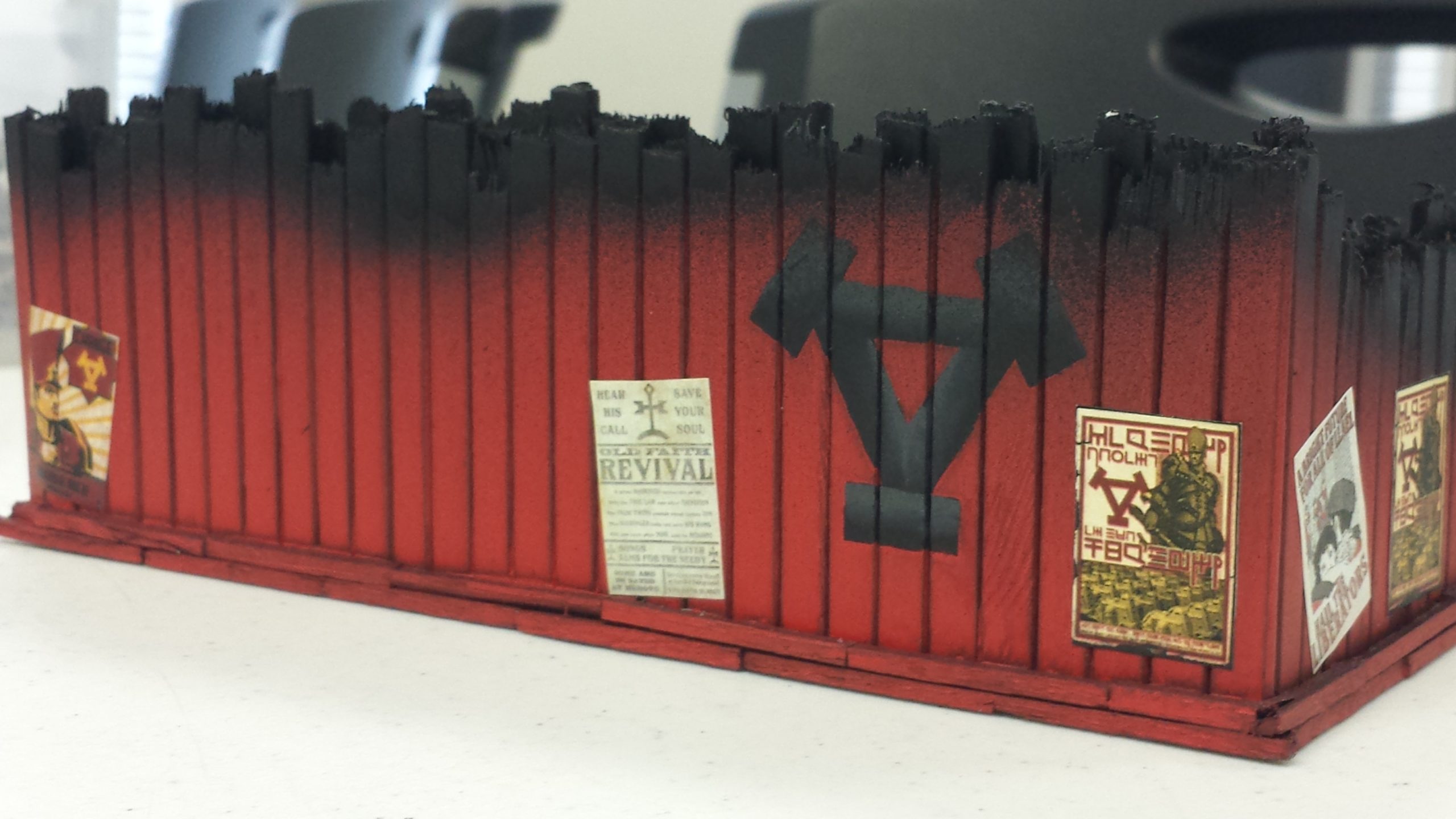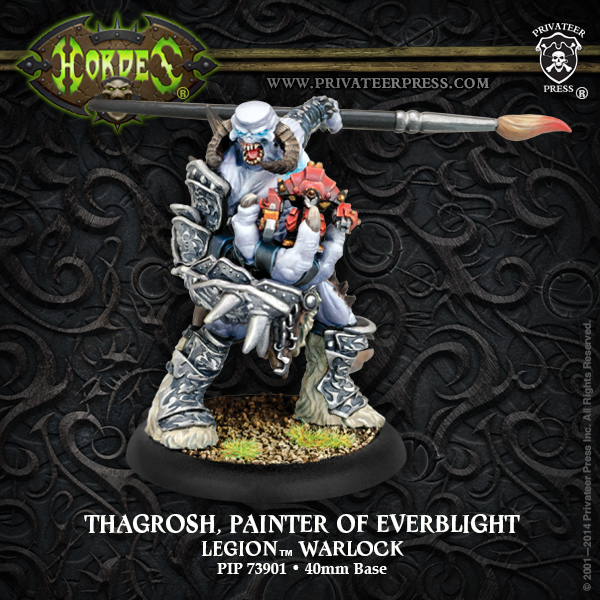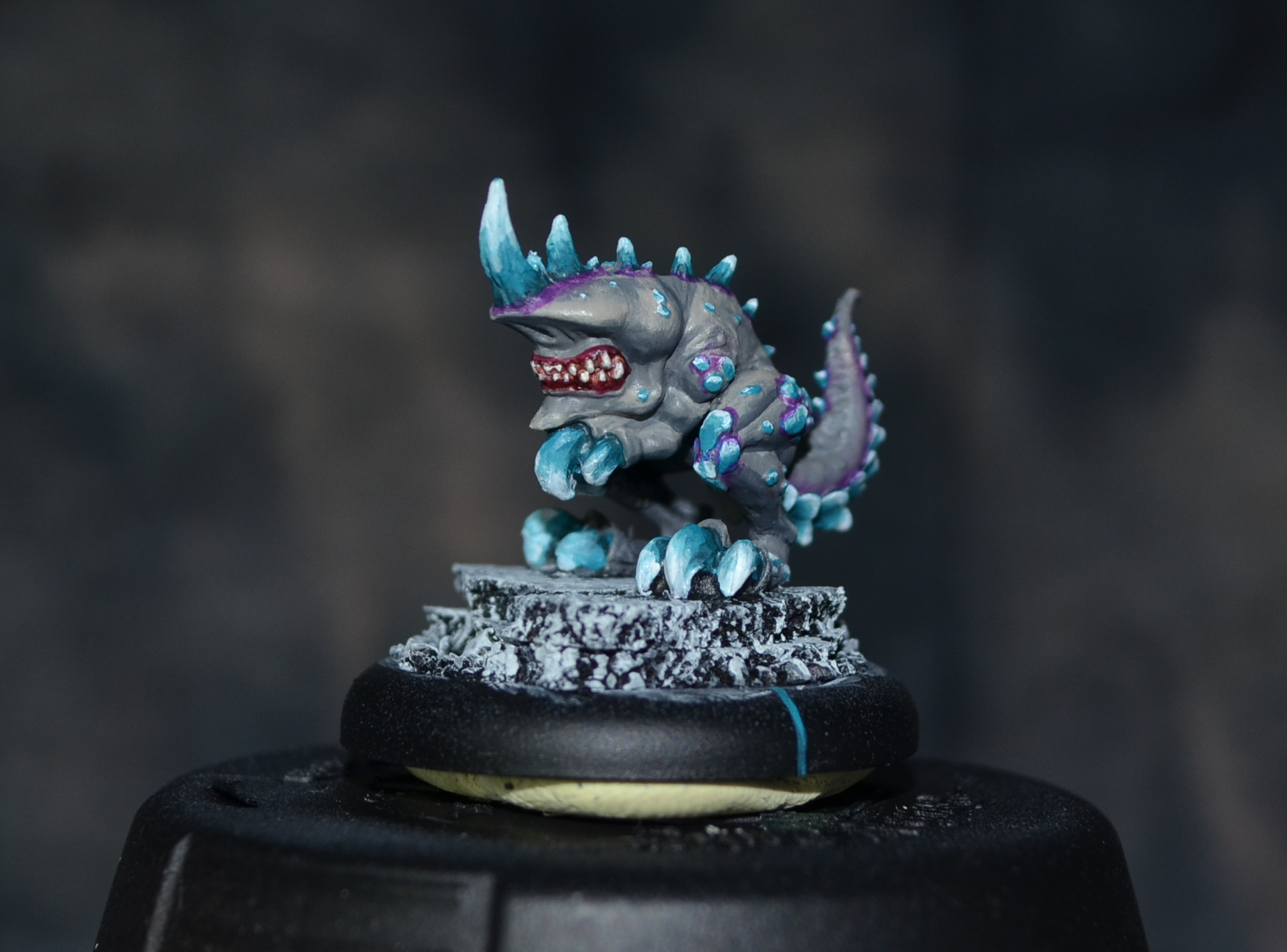[HtT][Terrain] Khadoran Trenchworks

Holy cow, it’s a How-to Tuesday. It’s been forever, right? Libby and I are both very excited! Ok, maybe she’s just excited about the peanut butter…
As the Nova Nomads club grows, we wanted to focus on what we had to offer our members and the other nearby play groups around us. One of these things is a positive and fun gaming experience. For the longest time, players have owned and maintained their own terrain sets because up until our current store, we couldn’t store anything at the shop. Given our new home store will allow us to do so, and we have club funding from dues (which also go towards club t-shirts, chess clocks, awards for events, etc), we wanted to get some club terrain.
In order to make this fun and exciting, and make sure we got the best looking terrain out of the time put into the project we made a competition out of it. Club members were encouraged to group up into teams of two (or solo or threes) and com up with a concept for a table’s worth of terrain. Lots of members had donated their personal sets to the club, so teams were free to take anything from that cache to use for their tables. Teams were given a tupperware bin for their terrain to fit into, and each team had a $25 budget on top of whatever the club purchased for them to use.
Most of our existing tables use forests, hills and linear obstacles. That’s great, but it leaves out lots of other fun terrain pieces like rough terrain, large obstacles, trenches, etc. Not to mention, the terrain rules support custom combinations of things, like rough terrain plus concealment might be brambles or long grass; something that slows you down and also obscures your position, but doesn’t offer nearly the same advantages as a wall or building.
I wanted to tackle trenches, because moist of our tables look like the random countryside with hills and forests and no buildings or signs of civilization. However, the Iron Kingdoms is full of battlefields and entrenched positions that nations feverishly defend and assault. I wanted a real battlefield. Since I had a ton of Khadoran bits laying around (mostly spare shields), I figured that faction was as likely to have trenches as any.
So, here’s how I went about building an entire table’s worth of terrain from scratch, in about three weeks.
Research
I started with research. I got out my (digital) copy of Prime MKII, and read about what constituted a trench and how they worked (Terrain starts on p86). I also wanted to include as many types of terrain as made sense for my theme. Hills, barricades, walls, minefields, broken or burned down buildings, etc all fit my idea. I’d love to have a water feature, but I just don’t see trenches being build so close to a water table – they’d just flood.
Once I knew what types of terrain I wanted, I started thinking about how much terrain I’d need. Most tables have 2 hills, 2 forests and 2 linear obstacles, and maybe something else. Six to seven is good, but more is better, so the players can choose to have a dense or sparse board and have options. After all, they don’t have to use all the pieces in the box, and having loads of choices means there’s re-play value.
One serious goal I had was to make sure I could do a long, winding trench if the players wanted to. Rather than do it in one piece, though, modular trench pieces would allow multiple configurations meant that stuff fit into the box better. I decided on at least two trench templates and one larger end piece, and if I had time, some corners for bends.
So, I ended up with a list that basically said “one of everything”, and then using whatever I had left to get in as many trenches as possible.
Planning the Build
I knew from working the terrain days at the NOVA Open that terrain is best when it doesn’t sacrifice function for form. Terrain can both look good and be very functional. For instance, I wanted my hill to have vertical sides. Sloped ones look cooler, but models fall off and there’s always the question of “Does partially on count as on the hill or not?” Having the model either on the hill or not means that question isn’t an issue. Likewise for my trenches; Prime shows a 3″ x 5″ trench template that has drawn on slopes and walls. However, models must be completely within that 3″ x 5″ area to count as being in the trench. That means you get the bonus if you’re on top of the walls / slopes?
That’s confusing, and obviously, we can do better on making the in vs out for trenches simpler.
I planned for my trenches to have the actual trench itself be 3″ x 5″, and the slopes and walls would be outside that. Thus, if a model was completely within the actual trench, it was in. If it wasn’t, then it wasn’t. Simple = easy, and easy = fun.
I found an article in NQ #29 for making trenches, and liked that the shorter walls they used still felt like trenches, but left slopes shallow enough for models to stand on. After some experimentation, I found that 0.5″ tall walls that ran 0.75″ were about right, so I ended up with 4.5″ x 5″ bases for my trenches.
I didn’t have access to MDF, a saw or sanding materials to bevel the edges, so I decided to use plasticard. I had some laying around that felt sturdy and wasn’t super thick (thus needing sanding to bevel the edges, the entire reason I didn’t go with MDF), and after measuring it turned out to be 1.5mm thick. I was able to buy three additional sheets for about $8 from my local RC and hobby train shop.
I got them home, got out the ruler, and started measuring out trench templates. Between the three sheets and the one I already had, I fit three normal trench templates, one dual trench template (you’ll see that below), three 45-degree corner trench pieces, a minefield and the base and walls for a burnt down barn / warehouse. (My forest base and trees were snagged from the club’s existing terrain stores.)
Construction
After cutting everything out, I sanded the one side of each of my bases with rough sandpaper (80 grit, I think). This gave my white glue something to hold to, and effectively removed any remaining mold release agent on the plasticard. It also made a mess.
I glued my sides of the warehouse to the base using super glue. While that was drying, I measured out 2″ and 2.5″ on my 5.75″ long popsicle sticks from Michaels. I then used the wire cutters I use to clip pins to help me make a semi-straight snap of the sticks. I wanted a rough ending, so it would look broken and burned. Eleventy bottles of glue and a billion (I counted) sticks later, and I have half of a burnt down warehouse. The small sticks at the bottom help cover up the rounded ends of the sticks I was too lazy to clip off. These were square matchstick type sticks also from Michaels. $3 gets you way more than you’ll need for this build.
For the trench slopes, I cut a few dozen wedges from spare pink insulation foam from work on our band saw. The 2″ thick foam is actually 1.5″, so that’s exactly double my wedge width. I cut the stuff into 4″ x 1.5″ x 0.5″ strips, then ripped those in half, giving me 4″ x 0.75″ x 0.5″ strips. Once I had about a dozen of these, I tilted the table to the right angle to slice the strips in half again, but on the diagonal. Once that was done, I had long thin wedges, 0.5″ tall and 0.75″ wide. Because they’re so thin, they’re easy to cut to length with a hobby knife.
While I had the foam out, I also cut out a 1″ tall hill. I had to use two sections, which I glued together with white glue and toothpicks acting as structural support.
After cutting up all the pink and gluing their parts to my trench templates, it was time to see what all this might look like on a table:
Looking good, so it’s back to work.
A gajillion more popsicle sticks cut to 2.5″ lengths gave me the boards needed to act as the walls on my trenches. I cut several more at 2.75″ long to act as the floor boards inside the trench. Also, I cut up a bunch of small 1.5mm x 1.5mm square sticks to be the vertical boards that get sunk into the ground to keep the wall boards in place. At this point I was really beginning to understand how Spud feels when he does his terrain builds: insane from all the monotony.
Once the walls and uprights were dry, it was time for spackle. This stuff was $3 from the local Home Depot, and will do a few different things. One, it seals the pink foam, making it ready for paint. Two, it adds some variety to the flat slopes, so they have a more organic feel. Three, it’ll let me effectively sink the floor boards into the base, so they look like they’ve been pounded into the mud from all the busy infantry running around – just push the boards down into the wet spackle. All the above also holds true for the minefield (with Darius’ mine markers for actual mines), hill and warehouse. I added water straight to the bin from the store, and used some crappy $1 brushes from Michaels.
This stuff usually takes 6-10-hours to dry through, especially when you’ve added water and laid it on as thick as I did. Mel, the Terrain Tutor‘s video on spackling hills was really helpful for this part of the whole thing. Also, those cheap palette knives are awesome for this, since the spackle just wipes right off the super slick plastic.
Once that was dry, I used super glue to glue down some odd details like shields and spare weapons and stuff. One of the best pieces I had was the ammo & helmet from the Bombshell Bombardier I tore up for Katya. Lastly, I used some white glue to apply down gravel / dirt.
Painting
I started by priming all the pieces black, using my airbrush. Spray paint might have been faster and cheaper, but I didn’t want to have to do it all outside.
I then used the airbrush to paint all the wood GreatCoat Grey. I wanted the wood to look old and waterlogged, so it would be a weathered, uncared for grey. Also, brown wood would disappear on brown dirt/mud, so the color difference helps the wood stand out.
After grey, I airbrushed all the dirt Battlefield Brown. I then did a heavy drybrush of my cheap craft store acrylics light brown, and followed that up with a light drybrush of a bone color. After that, I cleaned up the grey wood by brush.
Since I wanted the wood to look old and dirty, I drbrushed it with Trollblood Highlight, It’s a warmer, lighter grey, and makes the wood look stressed and covered in dust.
After that, I painted the detail pieces using a mix of 2-brush blending and washing. This is terrain, so I didn’t care to make it perfect, but at this point 2-brush is faster then layering for me, so it’s second nature.
For the last bit of visual variety, I had picked up two colors of Woodland Scenics foliage. One was a dry, burnt grass which had a dusty brownish-green color, and the other was a fresher, brighter green. I followed MisterJustin’s foliage tutorial on how to apply it. The only thing I did differently was to apply glue to the spots where I wanted the stuff to go, since it was such a rough surface to begin with. I mostly concentrated the foliage on spots where the dirt hadn’t stuck well and I had smooth patches of spackle showing through.
I knew I wanted a giant Khador symbol on the warehouse, so I blew up the Khador symbol from the Privateer Press website’s gallery page, and printed it out. I used a hobby knife to cut it out, and then traced it onto a spare piece of 2″ wide masking tape. I cut that out and applied the tape to the side of the building (which had already been primed black). A quick, thin shot of flat red spray paint on the outer walls gave them a nice worn look. I peeled off the mask, and was left with a Khador symbol in black. I touched this up with black paint where the red bled under the mask, and then did a quick 2-brush blend with GreatCoat Grey to make it look little three dimensional, like perhaps the guy that painted it wanted to do more than just a black outline. Lastly, I shamelessly stole some Khadoran Propoganda posters off the internet, shrunk them to be 1″ tall, and printed them out.

For the minefield, it was mostly just paint after the flocking. Though, I did want to have a sign reading, “Mines!!”, and I needed it to function like area terrain, so it wouldn’t impede movement. I made a sign and stuck it on a small base so it was removable. I then painted the shields to match my own Skorne and Protectorate, since they’re generic schemes.
Lastly, one of the guys had a cool old armorcast artillery piece that just barely fit onto a 50mm base, so I airbrushed it silver and added some red and brass bits to give it some flavor. It functions as an objective, for those inclined.
Despite trying on multiple occasions, I don’t have pictures of the full, painted table setup yet. Between dead batteries, full memory cards and other unknown phenomena, the terrain refuses to be photographed it it’s natural setting. As soon as I’m able, I will post the table in its entirety. I also know the gents over at Advanced Maneuvers filmed a battle report on it a week or two ago, so you can bet that I’ll post once that goes up.
Thanks for reading, Cheers!














Awesome stuff as always! I’ll be using some of these tips when it comes time for terrain time v2.0.